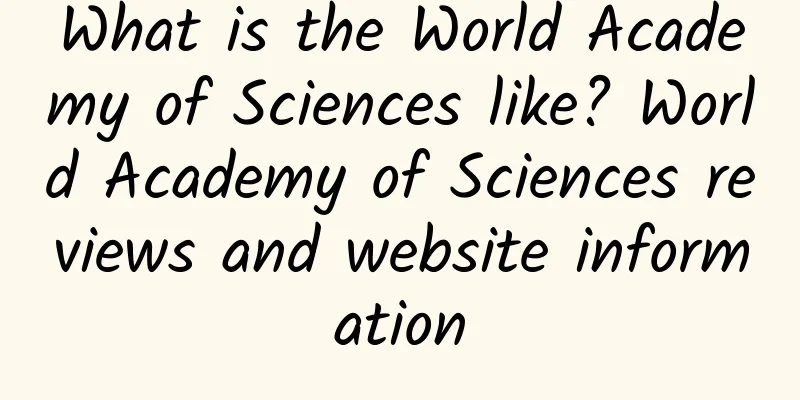What is the World Academy of Sciences like? World Academy of Sciences reviews and website information

|
What is the World Academy of Sciences website? The World Academy of Sciences (formerly the Third World Academy of Sciences) was founded in 1983 and is headquartered in Trieste, Italy. It is a non-profit academic organization. Website: twas.org The World Academy of Sciences for the Advancement of Science in Developing Countries (TWAS) is a world-renowned non-profit academic organization dedicated to promoting scientific development and technological innovation in developing countries. As a continuation of the former Third World Academy of Sciences (Academy of Sciences for the Developing World), the organization has been committed to promoting the dissemination of scientific knowledge, supporting scientific research and cultivating scientific and technological talents since its establishment in 1983. Headquartered in Trieste, Italy, TWAS enjoys a high reputation in the international scientific community and provides a platform for cooperation and communication for scientists around the world through a series of projects and activities. The core mission of TWAS is to help developing countries build a strong scientific foundation to achieve sustainable development. To this end, it not only provides scholarships, research funding and international cooperation opportunities, but also supports governments in formulating science development strategies through policy recommendations and science education programs. As a bridge connecting North and South countries, TWAS plays an important role in narrowing the scientific gap between developed and developing countries. This article will provide a detailed introduction to the history, organizational structure, main functions and global influence of the World Academy of Sciences. It will also explore how TWAS promotes scientific progress through specific projects and initiatives, especially in developing countries and regions. Finally, we will look forward to the future development direction of TWAS and its continued contribution to the global scientific community. Historical background and original intentionThe origin of the World Academy of Sciences can be traced back to the early 1980s, when the international scientific community generally realized that despite the remarkable achievements in science and technology in developed countries, many developing countries still lacked sufficient resources and capabilities to carry out high-level scientific research. This imbalance not only hindered the socio-economic development of these countries, but also limited the overall progress of global science. To meet this challenge, a group of outstanding scientists, including Nobel Prize winner in Physics Abdus Salam, founded the Third World Academy of Sciences (TWAS) in Trieste, Italy in 1983. The original purpose was to provide a platform for scientists in developing countries to showcase their research results and gain international recognition and support. Over time, TWAS gradually expanded its scope and officially changed its name to "World Academy of Sciences" in 2004 to more accurately reflect its global vision and goals. From its inception, TWAS established several key goals: to promote scientific research in developing countries; to strengthen South-South and North-South cooperation; and to promote the application of science in solving global problems. These goals remain the core guiding principles of TWAS's work today. Organizational structure and operating modelAs an independent non-profit academic institution, TWAS has a sound organizational structure to ensure the effective implementation of its various activities. Its highest decision-making body is the General Assembly of Academicians, which is composed of outstanding scientists from all over the world. These academicians are not only leaders in their respective fields, but also the main designers and promoters of TWAS policies and plans. In addition to the General Assembly, TWAS also has an Executive Committee and a Secretariat. The Executive Committee is responsible for overseeing the daily operations and strategic planning of TWAS, while the Secretariat is responsible for the management and coordination of specific projects. In addition, TWAS has established close cooperative relations with the United Nations Educational, Scientific and Cultural Organization (UNESCO) and other international organizations to jointly promote the development of global science. In terms of funding sources, TWAS relies on support from multiple channels, including membership fees, donations, international cooperation project funds, and funding from the Italian government and other governments. This diversified funding structure enables TWAS to flexibly respond to various needs while maintaining its independence and impartiality. Main functions and areas of activityThe functions and activities of TWAS cover a wide range of scientific fields, mainly including the following aspects:
All of these activities are aimed at strengthening scientific capabilities in developing countries and promoting equity and justice on a global scale. Contribution to the global scientific communitySince its establishment, TWAS has achieved many remarkable achievements. First, in terms of talent training, TWAS has funded thousands of scientists from developing countries, enabling them to receive training in world-class laboratories. After returning to their countries, these scientists have become the backbone of promoting local scientific development. Secondly, in terms of scientific research, TWAS has supported many significant research projects in areas such as climate change, energy, and health. These projects not only solve practical problems, but also open up new directions for future scientific research. Finally, in terms of international cooperation, TWAS has successfully built a scientific exchange platform that transcends national boundaries and cultures, through which scientists can share resources, exchange experiences, and jointly address global challenges. Challenges and future prospectsAlthough TWAS has achieved great success in the past few decades, it still faces some challenges. For example, how to maximize its influence with limited funds? How to adapt to the rapidly changing scientific and technological environment? How to further strengthen cooperation with the private sector and other stakeholders? These are all issues that TWAS needs to think about seriously. Looking ahead, TWAS will continue to uphold its core values and mission and strive to become a leader and promoter of global scientific development. Specifically, TWAS plans to increase investment in emerging technology fields such as artificial intelligence and gene editing; expand partnerships with other international organizations and companies; and strengthen support for young scientists. In short, the World Academy of Sciences is not only an academic institution, but also a bridge connecting scientists around the world. Through continuous efforts and innovation, TWAS will continue to contribute to the realization of a world without borders of science. |
Recommend
What is Freedom Group like? Freedom Group reviews and website information
What is Freedom Group? Freedom Group is one of the...
Ingredients and cooking methods of Eight Treasure Porridge
Autumn is dry, the skin is uncomfortable and dry,...
How to make coconut juice Ingredients and steps for making coconut juice
Friends who have been to Hainan have all drunk th...
What is ALDI like? ALDI reviews and website information
What is ALDI? ALDI is the largest supermarket chai...
What is Seagate Technology like? Seagate Technology reviews and website information
What is Seagate Technology's website? Seagate ...
Can fruit really help you lose weight? How to use fruit to lose weight
Nowadays more and more people are suffering from ...
What is The Times of India like? Reviews and website information of The Times of India
What is the website of The Times of India? The Tim...
The disadvantages of drinking soda The disadvantages of drinking soda frequently
In summer, we love to drink soda, which tastes go...
Nutritional value of fresh milk
Fresh milk is widely praised by the world. Europe...
What is Blackfriars College, Oxford University like? Reviews and website information of Blackfriars College, Oxford University
What is the website of Blackfriars, Oxford? Blackf...
How to treat toothache? Quick home remedies for toothache
There is a saying among the people that "too...
Is it better to eat garlic raw or cooked?
Garlic is a very special and nutritious ingredien...
How to cultivate the lucky Buddha's hand? How to cultivate the lucky Buddha's hand
The fortune-bringing Buddha's hand is one of ...
The efficacy and function of lantern fruit
The lantern fruit is a small shrub's fruit. T...
How to make scallop porridge
How to make scallop porridge? Let me tell you the ...









